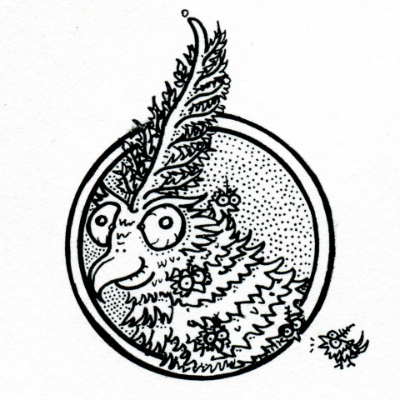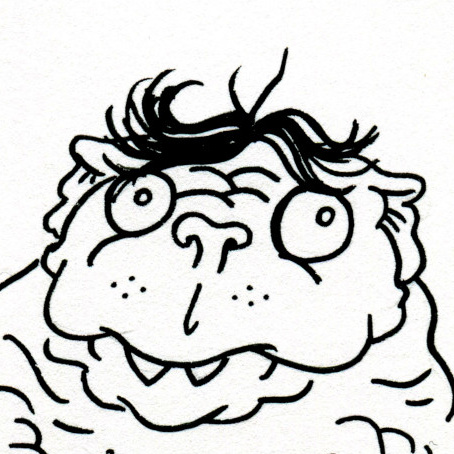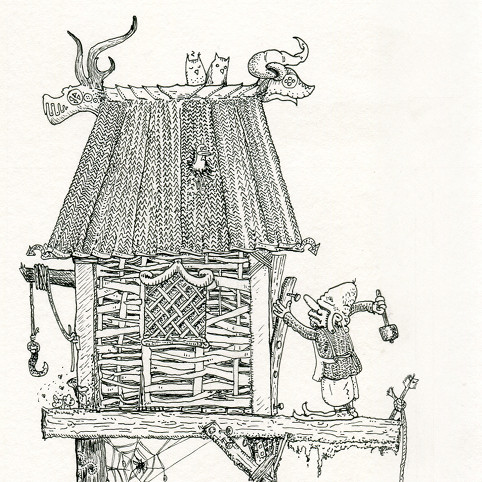
A short description (left to right) of several characters from different walks of life.
Five figures, Five Stories
A small crowd…
I. Korýnnes Volgwielle, Heerrevesser
The expert fisherman shows off his best catch of the season: a gold-specked Blinkskubbe†.
This species is among the rarest to prowl the waters of Zee‡. Literally worth it’s weight in gold, this bulky specimen is valued at a full seasons’ worth of fish. Korýnnes’ clothing is a mixture of styles from the many islands spread across the ocean, typical for a well traveled man such as himself.
This man is an elected Heerevesser; an individual chosen by the island communities to lead large fishing fleets across the seas. These extraordinary navigators can rally the sails of many communities behind them in times of need: Korýnnes organized the evacuation of the civilians of Kýsteen when that city was set ablaze during the disastrous Arys-Haltte war*.
II. Fiedeel Krielgat aka Breederiem°
A recurring character in urban working class humor is Fiedeel Krielgat. Fiedeel represents the stereotypical farmer; goodhearted but dimwitted, he is central to a plethora of jokes known as Schunzzes#. Most jokers have no idea that Fiedeel is an actual person, He leads a quiet life in BruynkeerreΔ with a wife and several children, who’ve inherited his scrawny buttocks.
Although many tales and jokes featuring Fiedeel are fictional, a good number are actually true:
In one of the stories Fiedeel accidentally slices himself in two while peeling carrots. His belt and his hat hold him together now, earning him the nickname ‘Breederiem’.
In another story Fiedeel sneezes so loud he scares away his own house.
Mostly the stories jokingly attribute all kinds of inventions to him:
Fiedeel once needed to go to the outhouse but stepped inside his cupboard instead, thereby inventing the indoor toilet.
III. Sýnnsse Joelbardde, Aksseling
The warrior posing here is an Aksseling◊. The combat role of Aksselingen is to slip into the massed pike formations, slash through the packed enemy ranks and take down their standard bearers. A frightening task, only attempted by the bravest fighters. It seems a suicidal act, but in their mind they strive for the highest glory a warrior may attain; to tear down the enemies colors and rip them apart.
During peacetime these characters are retainers & bodyguards to the ruling class. They act as champions in the duels and tournaments of lords & ladies. In short, these are the individuals in Bos who have identified & embraced their violent nature, and channel it into a life of military duty.
IV. Snamsse Bundeleer, Dorppelooper*
Most flightless bird-breeds posses an innate ability to parrot any sound they hear. Combined with their propensity for long-distance running this makes them ideal messengers.
A useful aspect of their parroting is that they neither have to understand the language nor the content of the message; a messenger bird may be dumb as rocks and will still be able to faithfully reproduce complex military plots, financial schemes or grandma’s grocery list.
Snamsse’s rather innocuous clothing will not draw too much attention when passing through various regions. He wears a sleeveless shirt because he likes to flail his arms about as he pulls off a sprint.
V. Juppe Desnongk, Markant
The famous Prince of Fruit has a sleek & delicate fencing sword at his side. It may not be useful on a battlefield but it is enough to repel thieves or defend his honor against competitors. The medallion on his chest bears the emblem of the Zwithoof†, proving his right to freely send his goods along the Keysweeghel‡.
In most communities, weaponry is held in stock by the local militia, to be handed out in times of need. This guarantees a chance for the community as a whole to defend itself from both internal & external threats. Merchants, however, are allowed to own private (bladed) weapons and openly carry them in most cities.
This is a ‘right’ tied to the beginnings of trade networks; early caravans would act as spies for rival lords, and caravan guards were often employed as mercenaries for the squabbling elites and rival families. (Who are often engaged in rivalries in which the local militias do not want to involve themselves.)
On Clothing
Clothing plays an important role in Bos society.
The fabrics and cuts are bound to a persons profession & social status. All embroidery, patchwork and cross-stitching is usually done by the individual itself, the symbols an expression of identity & personal values.
There are many rules outlining the proper use of symbolism. So many, in fact, that no one still bothers to follow them.
Merchants & sailors, especially, bend tradition without repercussion as they travel the world and patch all kinds of clothing together in puzzling combinations. Long-distance traders take pride in adorning themselves with piercings and medallions to hint at the faraway places they have visited.
Notes
Heerrevesser — Master Fisherman.
From German Heer (army) -also reminds of Dutch heer (lord)- and visser (fisherman), the German part refers to the large fishing fleets the Heerevessers own, armadas in their own right. The title also carries memories of a time when piracy was rampant among the islands.
Arys-Haltte War — A conflict that arose between the noble families of Arys and the brash, new trade-union of Haltte. This war started out as a quiet rumble; a string of skirmishes and raids grew into a full-scale war that stretched across the entire Bos coastline. Its culmination was the siege of Kýsteen-Oonde, then known as the Twin Cities, where the introduction of cannon on the battlefield caused the total destruction of Kýsteen.
Sketch of the battle outside Kýsteen-Oonde.
Blinkskubbe — translates to ‘Shinescale’.
From Dutch blinken (to flicker, shine) and schubben (scales)
Zee — reference to the great sea that lies west of the Bos mainland.
From Dutch zee (sea)
Krielgat — Small Ass.
From Dutch kriel (small) and gat (interpreted as ‘ass’)
Breederiem — Broadbelt.
From Dutch breed (broad) & riem (belt)
Schunzzes— Vulgar jokes, popular among the urban laborers. These are distinct from Boerttes which are popular jokes and tales among the peasantry. Throughout Bos peasants will occasionally look for employment in the cities when their farms require less work. In bigger cities however, an independent working class starts to form. Artisans produce year-round and cannot rely solely on the occasional help of farmhands.
From Dutch: schunnig (obscene, vulgar) and boer or boerte (peasant or folk tale)
Bruynkeerre — Unimportant hamlet located near a meander of the river Bruyn, where the fertile mud guarantees rich harvests. Fiedeel once tried to become a fisherman but the river kept avoiding him, leaving behind a muddy vale, so he became a farmer instead.
From Dutch bruin (brown) and keren (to turn, turning)
Aksseling — Axe wielder.
From Dutch aks (axe)
Pieketroep — Pike troup, the mainstay of contemporary Bos armies.
Dorppelooper — Village runner.
From Dutch dorp (village) and loper (runner)
Markant— Merchant Lord, the highest-ranking individuals of trade companies.
Zwithoof –The Second Court, a palatial estate belonging to the influential Fromagenet family. Clapping is not allowed here. (Clapping, by the way, was invented by Fiedeel when he tried to grab something that wasn’t there.)
From German zwei, zweite (two, second) and Dutch hof (court).
Keysweeghel — Cheese Road, famous trade route that connects many regions of Bos.
From Dutch kaas (cheese) and weg, wegel (road)







